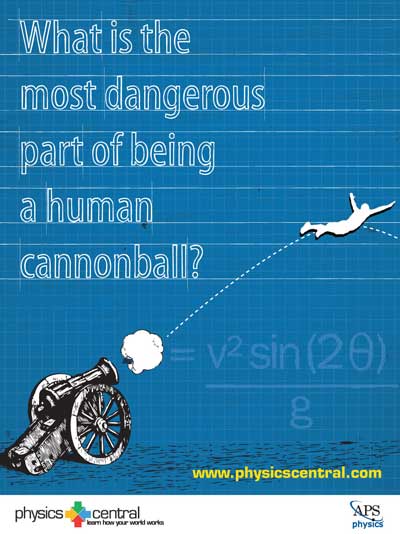What is the Most Dangerous Part of Being a Human Cannonball?
“Ladies and gentlemen, boys and girls, children of all ages, you are about to witness a man who flies with the birds. Meet the Human Cannonball.” Since 1877 at the Royal Aquarium in London when Zazel, a fourteen year old girl became the first human cannonball, people have gathered at circuses around the world to watch others take this mind-blowing flight.
In 1877, Zazel used a cannon that was mechanized with elastic bands connected to a platform inside the cannon to propel herself into the sky. Although this was a start, human cannonballs today prefer to use a system that applies condensed air as the means of propulsion. In this system a tank of condensed air is quickly released into the cannon, which pushes the platform to the end of the cannon, where the platform stops abruptly and the human cannonball is pushed into the air, through inertia (an object in motion stays in motion), she flies.
Being propelled out of the cannon may seem like tricky business; however, it is not the most dangerous part of being a human cannonball. When the human cannonball is accelerating inside the cannon, her body feels the effects of this acceleration, but it is not to the extent that her body cannot handle it. Some human cannonballs undergo training like astronauts to be able to handle this rapid acceleration with more comfort. The further the human cannonball needs to fly, the more forceful the propulsion will be and the faster the acceleration will be. This is shown through Newton’s second Law of motion which says that force equals mass times acceleration, which basically means that if the force applied to an object is increased, the acceleration of that object will also increase.
The motion of the human cannonball as she flies like a rocket over the audience’s heads happens in two dimensions, horizontal and vertical. The cannon propels her up (vertical) and out (horizontal) and then she falls (vertical). To make sure she hits her target, she must consider how far she is going to fly and how far she is going to fall. These limits are usually set by the other acts that happen in the circus ring. For example, high in the ring are rafters and wiring for other performers, such as trapeze artists or tight rope walkers. If a human cannonball collides with any of these objects it could be very dangerous. Also, she cannot fly past the ring or she will end up falling on top of the audience. In her calculations she must consider her height of flight as well as her range.
The only acceleration, how fast she speeds up, affecting her after she is shot out of the cannon at her beginning speed is the acceleration of gravity, which will be pulling her down at 9.8 m/s2. As she starts flying up, she slows down until she is not going up any more and then starts falling toward the ground because of gravity. Her horizontal velocity, how fast she is moving across the sky, should remain the same throughout the flight except for the effect of air resistance, the air pushing against the human cannonball. If air resistance is overlooked the problem can be broken down into just the horizontal velocity, the speed across the sky, which remains the same and the vertical velocity, the speed up and down, which changes due to gravity. The more wind or other forces that come into play, the more complex the equation becomes and the possibility of miscalculating your landing increases.
Now on to the most dangerous part, landing. Just as the human cannonball must accelerate to be able to fly through the air, they must decelerate to land. The quicker this deceleration happens, the more dangerous and potentially fatal the outcome. That is why human cannonballs fly into nets or bodies of water. The net and body of water slow down the deceleration of the human cannonball, until she comes to a safe stop. If the human cannonball overshoots or misses the net and lands on the ground, the deceleration happens almost instantly and the human cannonball’s body sustains almost all the energy that was transferred during impact. A net or water is more forgiving than the ground because it is able to move with the human cannonball. By moving with the human cannonball, the net will absorb most of the cannonball’s energy. If the human cannonball hits the ground, the ground can’t move so the cannonball decelerates quickly and will absorb the energy with unfortunate results.
Being a human cannonball requires a lot of attention to detail. They must be able to do the math correctly every time as if their life depended on it, which it does. The cannon must be fire with the right acceleration and force and every time she performs she must recalculate and check her equipment before taking to the skies. Before considering being a human cannonball, make sure to brush up on trigonometry or the mind-blowing experience, may just literally blow your mind.
For more information:
'Head for heights required', BBC News
Physics Made Simple: The Human Cannonball, Christopher Gordon De Pree, Ira Maximilian Freeman
How do "human cannonballs" survive?, The Straight Dope












